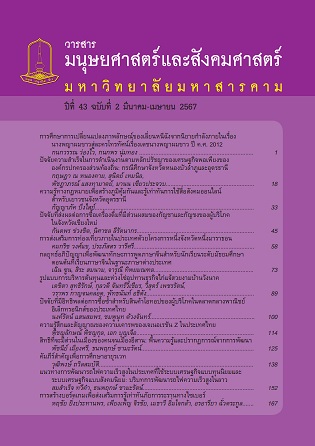แนวทางการพัฒนารถไฟความเร็วสูงในประเทศที่ใช้ระบบเศรษฐกิจแบบทุนนิยม และระบบเศรษฐกิจแบบสังคมนิยม: บริบทการพัฒนารถไฟความเร็วสูงในลาว
Main Article Content
บทคัดย่อ
การพัฒนาระบบโครงสร้างพื้นฐานของประเทศเพื่อส่งเสริมการพัฒนาเศรษฐกิจ-สังคมทั้งประเทศที่ใช้ระบบเศรษฐกิจทุนนิยมและประเทศที่ใช้ระบบเศรษฐกิจแบบสังคมนิยมหรือระบบเศรษฐกิจแบบผสม ได้ส่งผลให้เกิดการขยายตัวของเมือง ซึ่งทำ ให้เกิดปัญหาต่างๆ ตามมา เช่น ปัญหาการจราจรปัญหามลพิษ ปัญหาสิ่งแวดล้อม ปัญหาสังคม เป็นต้น บทความนี้มีวัตถุประสงค์เพื่อนำเสนอแนวทางการพัฒนารถไฟความเร็วสูงของประเทศที่ใช้ระบบเศรษฐกิจแบบทุนนิยมและประเทศที่ใช้ระบบเศรษฐกิจแบบสังคมนิยมในบริบทที่แตกต่างกัน รวมถึงหลักการพัฒนาพื้นที่รอบสถานีขนส่งมวลชนและการเสนอแนะแนวทางบูรณาการพัฒนาพื้นที่รอบสถานีรถไฟความเร็วสูงนครหลวงเวียงจันทน์และวังเวียงในลาวโดยการเก็บรวบรวมข้อมูลที่เกี่ยวข้องจากการตีความจากหนังสือ บทความวิชา การงานวิจัย และวารสารต่างๆ ตามแนวทางระเบียบวิธีวิจัยเชิงคุณภาพ ผลการศึกษาพบว่าแนวทางของการพัฒนาระบบรถไฟความเร็วสูงของแต่ละประเทศมีความแตกต่างกันขึ้นกับบริบทของพื้นที่ทางภูมิศาสตร์งและเน้นการสร้างเครือข่ายรถไฟความเร็วสูงเชื่อมระหว่างเมืองและระหว่างประเทศเพื่อพัฒนาในมิติต่างๆสำหรับการพัฒนาพื้นที่รอบสถานีรถไฟความเร็วสูงของลาวเพื่อการพัฒนาที่ยั่งยืน ควรบูรณาการในหลายมิติทั้งบริบทของพื้นที่/ความพร้อมทางกายภาพของพื้นที่ การปรับตัวของชุมชนที่ได้รับผลกระทบและหลักการของการพัฒนาพื้นที่รอบสถานีรถไฟความเร็วสูง
Article Details
เอกสารอ้างอิง
กรมอาเซียน. (2561). ความเชื่อมโยงระหว่างกันในอาเซียน (ASEAN connectivity). https://image. mfa.go.th/mfa/0/OcXc7u4THG/migrate_directory/other-20180829-175021-530335.pdf
จรินทร์ทิพย์ สายมงคลเพชร. (2563). ความเป็นศูนย์กลางของอาเซียน: การส่งเสริมความเชื่อมโยง ระหว่างกันในอาเซียนและการรวมตัวกันทางภูมิภาค. สังคมศาสตร์และมนุษยศาสตร์, 46(1), 68-89. https://kukrdb.lib.ku.ac.th/journal/jssh/search_detail/result/408615
บุญทวี สอสัมพันธ์. (2557). การพัฒนาการท่องเที่ยวแบบยั่งยืนโดยชุมชนในเมืองวังเวียง สปป. ลาว [วิทยานิพนธ์ปริญญาศิลปศาสตรดุษฎีบัณฑิต, มหาวิทยาลัยขอนแก่น]. มหาวิทยาลัย ขอนแก่น.
Albalate, D., & Bel, G. (2012). High-speed rail: Lessons for policy makers from experiences abroad. Public Administration Review, 72(3), 336-349. https://doi.org/10.1111/j.1540- 6210.2011.02492.x
Asian Development Bank. (2012). Lao People’s Democratic Republic: Urban development sector assessment, strategy, and road map. https://www.adb.org/sites/default/files/institutionaldocument/33722/files/lao-pdr-urban-sector-assessment.pdf
Bruinsma, F., Pels, E., Priemus, H., Rietveld, P., & Wee, B. (2008). Railway development: Impacts on urban dynamics. University of Amsterdam. Springer Science & Business Media.
Calthorpe, P. (1993). The next American metropolis: Ecology, community and American dream. In Angewandte Chemie International Edition (pp. 951-952). Princeton Architectural Press.
Cervero, R. (2006). Public transport and sustainable urbanism: Global Qualitative Research in Psychology. https://escholarship.org/content/qt4fp6x44f/qt4fp6x44f_noSplash_e 54103209a50d6f28c82c41cbb06de1f.pdf?t=lc4zd0
Chow, G. C. (2004). Economic reform and growth in China. Annals of Economics and Finance, 5(1), 127-152.
Cox, M., Majid, T. S. M., Jie, Y., Yan, J., Hamzah, H., Jusoh, S., Casarini, N., Loong, P., Tay, K., & Pongsudhirak, T. (2018). China’s belt and road initiative (BRI) and Southeast Asia. LSE Ideas; CIMB ASEAN Research Institute.
Cui, S., Pittman, R., & Zhao, J. (2021). Restructuring the Chinese freight railway: Two scenarios. Asia and the Global Economy, 1(1), 100002. https://doi.org/10.1016/j. aglobe.2021.100002
Dai, G. (2015). The impact of policy networks on the urbanization around High-Speed Railway stations in China: the case of Wuhan. Environment and Planning C: Government and Policy, 33(3), 533-551. https://doi.org/10.1177/0263774X15594016
Hamstead, M. P., & Quinn, M. S. (2005). Sustainable community development and ecological economics: Theoretical convergence and practical implications. Local Environment, 10(2), 141-158. https://doi.org/10.1080/1354983052000330743
Haider, J., Rodrigues, S., Pettit, J. H. (2021). Economic and environmental impacts of alternative routing scenarios in the context of China’s belt and road initiative | Elsevier Enhanced Reader. Maritime Transport Research Journal, 2, 030.
History. (2022). Energy crisis (1970s). A&E Television Networks.
Japan International Cooperation Agency. (2011). Understanding institutional challenges for urban planning in Vientiane capital, Lao PDR. http://ucrsea.ca/wp-content/uploads/2017/07/ Urban-Planning-in-Vientiane-brief-Daniel-Hayward.pdf
Jia, J., & Fang, Y. (2016). Underground space development in comprehensive transport hubs in China. Procedia Engineering, 165, 404-417. https://doi.org/10.1016/j. proeng.2016.11.716
Lee, H. L., & Shen, Z. J. (2020). Supply chain and logistics innovations with the Belt and Road Initiative. Journal of Management Science and Engineering, 5(2), 77-86. https://doi. org/10.1016/j.jmse.2020.05.001
Pandey, B. (2022). Infrastructure inequality is a characteristic of urbanization. Sustainability Science, 119, 4-11. https://doi.org/10.1073/pnas.2119890119/-/DCSupplemental. Published
Renne, J. L. (2020). Transit oriented development literature review. Transit Oriented Development. The Swedish Knowledge Center.
Roseland, M. (2000). Sustainable community development: Integrating environmental, economic, and social objectives. Progress in Planning, 54(2), 73-132. https://doi.org/10.1016/ S0305-9006(00)00003-9
Royal Thai Embassy. (2019). Lao PDR accelerates tourism development important factor for economic growth. https://globthailand.com/laos-21102019/
Shaikh, S. (2012). Comparative economic systems: A brief review. Islamic Economics Project.
Shin, D. C. (2005). Recent experience of and prospects for high-speed rail in Korea: Implications of a transport system and regional development from a global perspective. http://escholarship.org/uc/item/5wn7600s
Suyama, Y. (2014). 50 years of Tokaido Shinkansen history. Japan Railway & Transport Review, 64, 18-27.
UN-Habitat Lao PDR. (2020). Urbanization: A rapidly emerging development issue for Lao PDR. https://docplayer.net/216200222-Urbanization-a-rapidly-emerging-developmentissue-for-lao-pdr.html
Vijayachandran, K. (2014). Perestroika glasnost and socialism. Partridge.
Wang, G., & Leung, P. M. F. (1998). One country, two Systems: Theory into practice. Pacific Rim Law & Policy Association, 7(2), 279-320.
Yamada, N. (2013). Re-thinking of “ Chintanakan Mai ” (New Thinking): New perspective for Understanding Lao PDR. IDE Discussion Paper, 393, 1-44.
World Bank. (2017). Lao economic monitor: Challenges in promoting more inclusive growth and shared prosperity. https://openknowledge.worldbank.org/entities/publication /6fb97296-e6e1-56a8-a96a-1e0cfe6359bd


